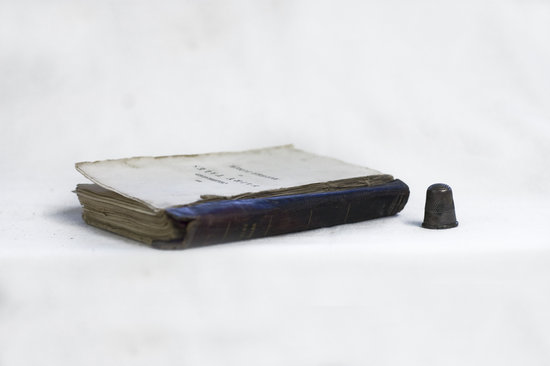THE CELEBRATED FAIRY TALES OF MOTHER BUNCH
Authors: d'Aulnoy, Madame
d'Auneuil, MadameCategories: Fiction
Children / Youth ProseYear: 1817
Date Details: August 25, 1817 (Part I); September 20, 1817 (Part II)
Publisher: John Harris, Corner of St. Paul's Church Yard (c. 1756-1846)
Pagination: 152 (Part I, 76; Part II, 76)
Dimensions: 13.5 x 9 cm
Illustrations: 12 plates. Frontispiece, Vol. I: '"Prince Lupin," Published Aug.st. 25. 1817. By J. Harris, corner of St. Pauls'; p. 13: "Frutilla"; p. 25: "The Yellow Dwarf"; p. 36: "Constantia"; p. 43., etc.
City: London
Document Type: Book
Language: English
Printer: Henry Bryer, Bridge Street, Black Friars, London
Price: 6d.
Binding: Quarter calf, front and back covers marbled board [front cover missing]. Spine [gilt tooling]: 'FAIRY/TALES'
Edges: Trimmed
Notes:Full title: THE | CELEBRATED | FAIRY TALES | OF | MOTHER BUNCH, | NOW REPUBLISHED | WITH APPROPRIATE ENGRAVINGS, | FOR THE AMUSEMENT OF THOSE | LITTLE MASTERS AND MISSES, | WHO, BY DUTY TO THEIR PARENTS, | AND OBEDIENCE TO THEIR SUPERIORS, | ARE LIKELY TO BECOME GREAT LORDS AND LADIES. Part I and II. Authorship: Madame d'Aulnoy (Part I); Madame d'Auneuil (Part II), under the psuedonym "Mother Bunch". Although the fairy tales contained in this book are adaptations of those written by Madame d'Aulnoy and Madame d'Auneuil in the late seventeenth century, the authorship is credited to "Mother Bunch"--a fictitious English folk figure who first appears in the sixteenth century as an alewife and bawd, and over the centuries comes to represent the old and lower class wisewoman and taleteller. By the nineteenth century, she had been transformed into a matronly nanny figure and teller of instructional fairy tales. The real authors--Madame d'Aulnoy and Madame d'Auneuil--are uncredited. The six fairy tales in Part I are adaptations of Madame d'Aulnoy's works. Marie-Catherine d'Aulnoy (c. 1650-1705) was an aristocrat and popular author whose works include novels, fairy tales, and memoirs. She is best known for her fairy tales and is credited with coining the term "fairy tale." Her folk stories are largely moralistic in tone and directed at upper-class adults. The five Oriental-inspired fairy tales in Part II are adapted from the French fairy tales of Madame d'Auneuil (?--c. 1700). There is little known about Louise de Bossigny, Comtesse d'Auneuil, other than the fact that she belonged to the French upper-class and wrote several popular books of fairy tales in the late seventeenth century. The final fairy tale of the volume, "The Story of Little George," is similarly uncredited and does not seem to be the work of either Madame d'Aulnoy or Madame d'Auneuil. Publisher info: John Harris began his career as a publisher and bookseller as an apprentice to Thomas Evans. He briefly worked for John Murray before becoming the manager for publisher Elizabeth Newbery. The Newbery firm was one of the first publishing companies to specialize in publishing children's literature in the eighteenth century. Harris bought Newbery's business between 1801 and 1802. He continued to specialize in children's literature, although he also issued publications such as the Gentleman's Magazine. Harris experienced great success with small picture books, and published a series of texts that combined engraved texts and plates following the popularity of The Comic Adventures of Old Mother Hubbard and Her Dog. He died a wealthy man, leaving 30,000 pounds to his family and friends in investments and bequests. Contents: p. i, vol. I title-page and publisher's imprint. p. ii printer's imprint. p. 1-76 text. p. i, vol. II title-page and publisher's imprint. p. ii printer's imprint. p. 1-76 text. The Celebrated Fairy Tales of Mother Bunch is a collection of fairy tales for middle- to upper-class children that, as immediately indicated by the book's extended title, are largely moralistic in tone. The tales are intended to both amuse and instruct, combining exotic tales of princes and princesses with lessons on the importance of duty, obedience, steadfastness, and compassion and the consequences of sloth, vanity, and greed. The instructional purpose of the fairy tales is made clear in the final tale of the book, "The Story of Little George," in which the old fairy 'Instruction' introduces Little George and his brother Henry to the principles of Truth, Modesty, Natural Affection, and Good Temper. Although the book is divided into two parts, it appears that it was originally sold as one unit. This collection of fairy tales was published at a time when the genre was experiencing a resurgence in popularity, issued only two year after the Brothers Grimm published their famous expanded edition of Children's and Household Tales. References: Blamires, David. “From Madame d’Aulnoy to Mother Bunch: Popularity and the Fairy Tale.” Popular Children’s Literature in Britain. Eds. Julia Briggs et al. Ashgate, 2008. Shefrin, Jill. "Harris, John (1756–1846),"Oxford Dictionary of National Biography, Oxford University Press, 2004 [http://www.oxforddnb.com/view/article/12401, accessed 20 May 2009] Sumpter, Caroline. The Victorian Press and the Fairy Tale. Palgrave Macmillan, 2008. Zipes, Jack. Fairy Tales and the Art of Subversion. New York: Wildman press, 1983.


















